The AMD Radeon R9 290 Review
by Ryan Smith on November 5, 2013 12:01 AM EST- Posted in
- GPUs
- AMD
- Radeon
- Hawaii
- Radeon 200
Overclocking
Finally, let’s spend a bit of time looking at the overclocking prospects for the 290. Without any voltage adjustment capabilities and with AMD binning chips for clockspeeds and power consumption we’re not necessarily expecting a lot of headroom here, but none the less it’s worth checking out to see how much more we can squeeze out of the card.
Even though we’re officially limited to AMD’s Overdrive utility for the moment for overclocking, Overdrive offers a wide enough range of values that we shouldn’t have any problem maxing out the card. In fact we’ll be limited by the card first.
| Radeon R9 290 Overclocking | |||
| Reference Radeon R9 290 | |||
| Shipping Core Clock | 662MHz | ||
| Shipping Boost Clock | 947MHz | ||
| Shipping Memory Clock | 5GHz | ||
| Shipping Boost Voltage | ~1.18v | ||
| Overclock Core Clock | 790MHz | ||
| Overclock Boost Clock | 1075MHz | ||
| Overclock Memory Clock | 5.6GHz | ||
| Overclock Max Boost Voltage | ~1.18v | ||
Despite the lack of voltage control, when it comes to overclocking the 290 we were able to achieve solid overclocks on both the GPU and the memory. On a boost clock basis we were able to push the 290 from 947MHz to 1075MHz, an increase of 128MHz (14%). Meanwhile we were able to push the memory from 5GHz to 5.6GHz before artifacting set in, representing a 600MHz (12%) memory overclock. Being able to increase both clockspeeds to such a similar degree means that no matter what the video bottleneck is – be it GPU or memory – we should see some kind of performance increase out of overclocking.
On a side note, for overclocking the 290 we stuck with moderate increases to both the maximum fan speed and the PowerTune limit. In the case of the former we used a 65% maximum fan speed (which actually proved to be more than what’s necessary), while for the latter we went with a 20% increase in the PowerTune limit, as at this point in time we don’t have a good idea for what the safe power limits are for the reference 290/290X board. Though in either case only FurMark could push the overclocked card to its power limit, and nothing could push the card to its fan speed limit. Similarly we didn’t encounter any throttling issues with our overclocked settings, with every game (including CoH2) running at 1075MHz sustained.
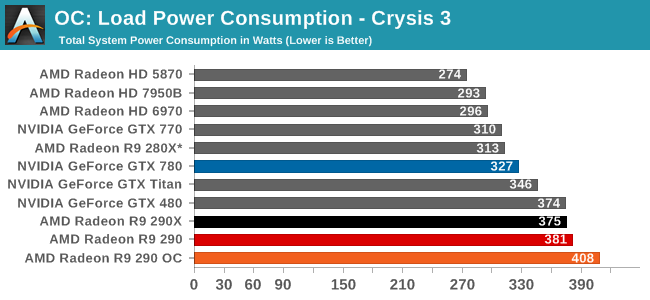
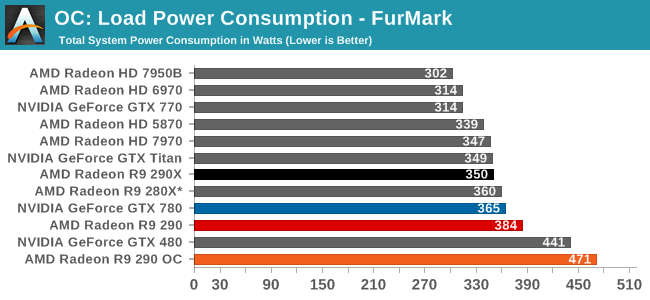
Taking a brief look at power, temp, and noise before jumping into our gaming performance results, we can see that overclocking the card has a measurable impact on power consumption under both Crysis 3 and FurMark. With Crysis 3 we’re clockspeed limited before we’re power limited, leading to an increase in power consumption of 27W, while under FurMark where we were power limited it’s a much more academic increase of 87W.
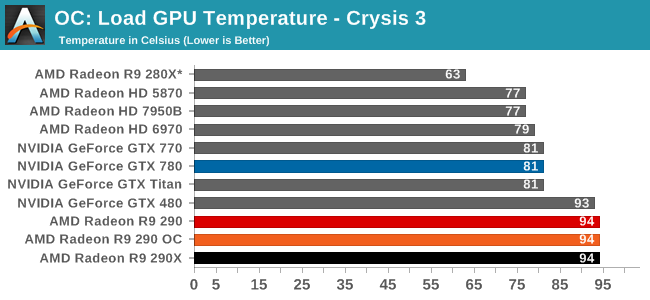
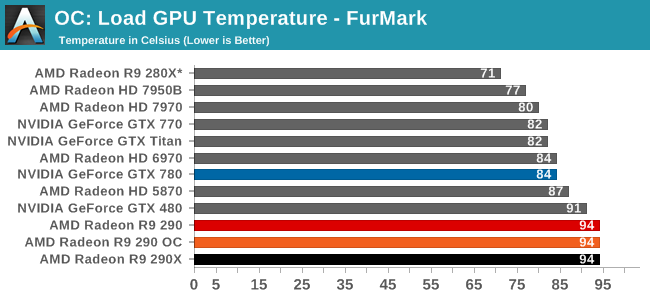
Since the 290 already ships at the highest temperate limit it allows – 95C – our sustained temperatures are unchanged even after overclocking.
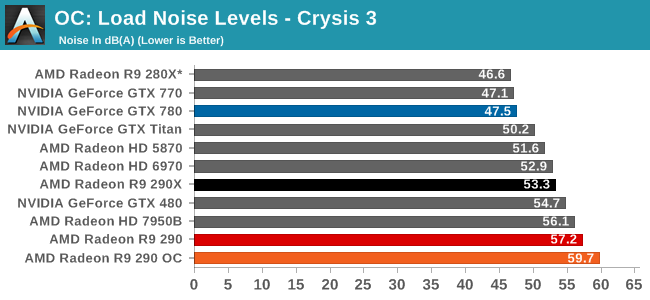
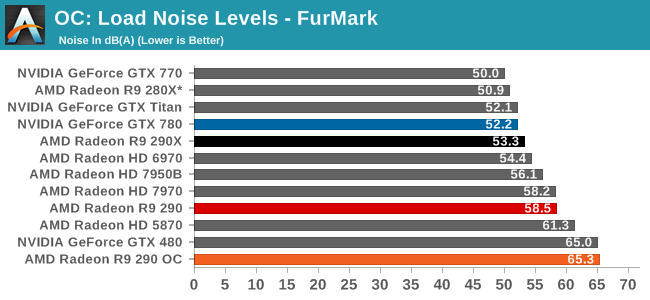
The 290 is already an unreasonably loud card at stock, and unfortunately the fan speed increases needed to handle the greater heat load from overclocking only make this worse. Under Crysis 3 we peaked at 59.7dB, or 49% fan speed. While under FurMark we peaked at 65.3dB, or 59% fan speed. For these noise levels to be bearable the 290 really needs to be fully isolated (e.g. in another room) or put under water, as otherwise 59.7dB sustained is immensely loud for a video card.
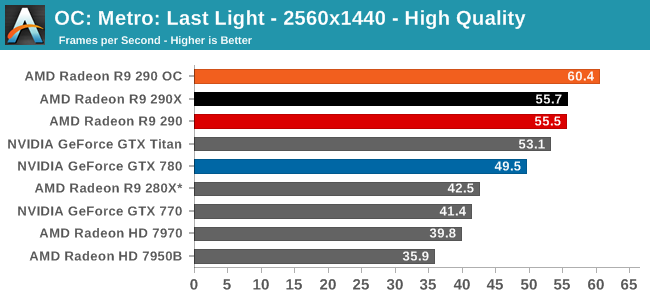
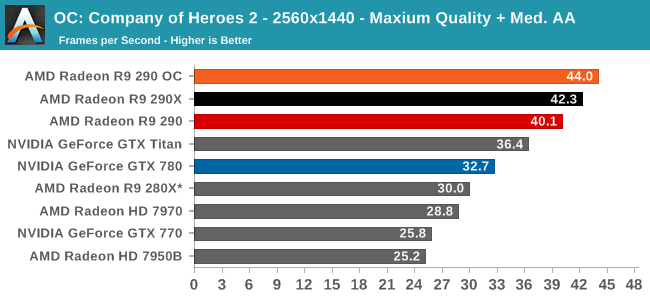
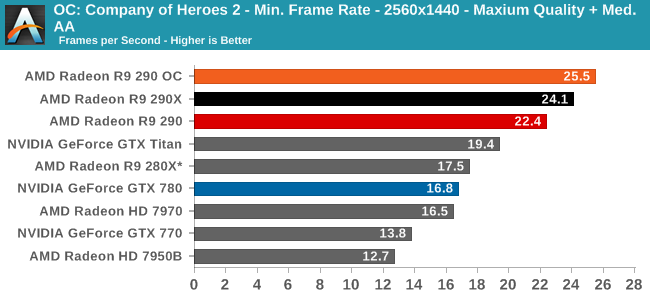
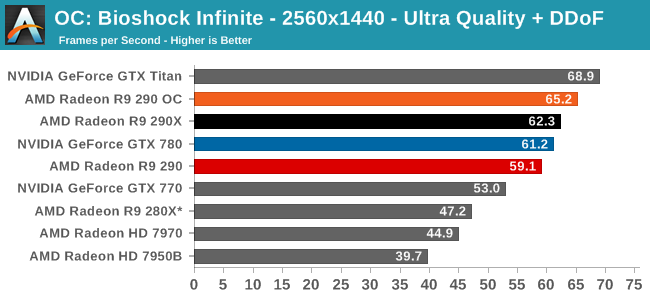
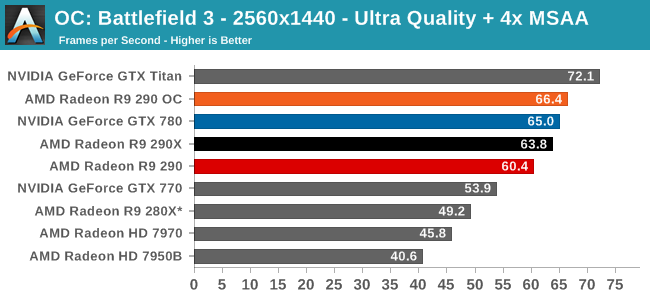
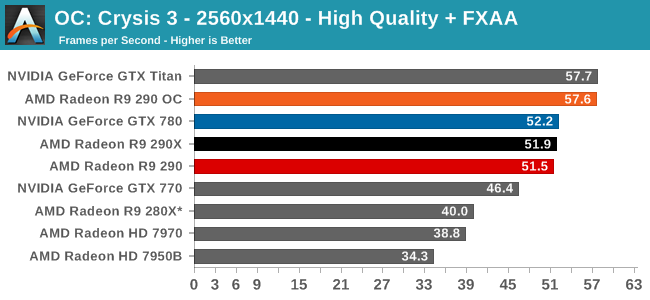
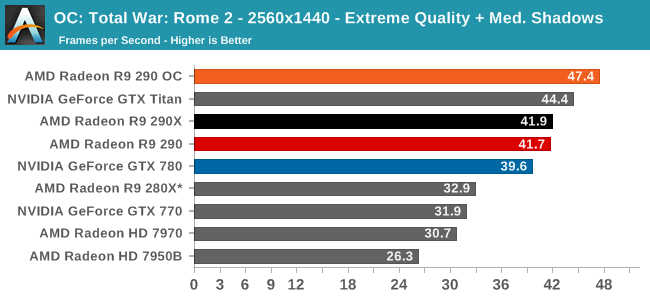
Finally getting to the matter of game performance, we’re seeing consistently strong scaling across every game in our collection. The specific performance increase depends on the game as always, but a 14% core overclock and 12% memory overclock has netted us anywhere between 9% in Metro up to the full 14% in Total War: Rome II. At this performance level the 290 OC exceeds the performance of any other single-GPU card at stock, and comes very close to delivering 60fps in every action game in our benchmark suite.










295 Comments
View All Comments
HisDivineOrder - Tuesday, November 5, 2013 - link
I don't think you get how loud they're saying this card is, but go on, buy it. I think you'll figure it out pretty quick.JDG1980 - Tuesday, November 5, 2013 - link
That will be completely irrelevant in a couple of weeks when aftermarket designs become available. The reference cards are pretty much for water block users only.nathanddrews - Tuesday, November 5, 2013 - link
I get it that being quiet is a nice feature... but it's way at the bottom of my list. I want the most frames for the dollar followed by thermals and then power usage. Then, way under that, I care about acoustics. The article sure fusses a lot given that AMD very rarely makes quiet coolers. The aftermarket cards will all sport more efficient dual/triple fan setups... or silent water blocks...hoboville - Tuesday, November 5, 2013 - link
Basically this, if 3rd parties make custom PCBs with custom VRMs, you probably won't be able to affix a waterblock, because they are usually built for reference designs.To the guy who says "he's focusing too much on noise" has no idea what a fan at 60 DB sounds like. Basically, take an industrial fan, and point it at your face, and turn it on medium. Or, drive with your windows down at 45 MPH. It's distracting.
HisDivineOrder - Tuesday, November 5, 2013 - link
Exactly.nathanddrews - Tuesday, November 5, 2013 - link
I don't know about you, but I have my PC under my desk about 4-6 feet from my face. I think AT measures decibels at 12 inches. Even if they measure from 24 inches, that's a HUGE difference in perceived noise in real life. Between deflection, pitch, and attenuation, these decibel measurements are a waste of time in many applications. It's good to have objective data to compare, but unless your PC is sitting right up on your desk next to your monitor about the same distance from your face would it be distracting... and only under load... assuming there were no other sounds coming from your speakers (silent gaming?).Come to think of it, my HTPC is stored in an AV closet (totally silent) and my other HTPCs are hidden away and not audible. This card is amazing despite its SPL.
Galidou - Tuesday, November 5, 2013 - link
Wait for the new custom coolers, improved fps with upcoming drivers like any new products that takes time to adjust. Another comment about a crappy AMD cooler, like if anyone of us didn't know it's crappy, you had to fanboy comment about how crappy it is, I ALREADY got it from reading the review thanks!''Basically, take an industrial fan, and point it at your face, and turn it on medium. Or, drive with your windows down at 45 MPH. It's distracting. ''
Drive your 100k$ car right in a wall, destroy it, it's annoying. Everyone knows that, how obvious life can be sometimes. Another comparison that sounds as stupid as can be. PS I was sarcastic about the car, don't do it... while the guy above thought he was serious... OMG
Wait for aftermarket coolers, Nvidia got amazing launch results cauz they have very good coolers, this is already AMAZING and that's with the WORST cooler EVER, 2 weeks from now everyone will be in exctasy with the superb Asus DCU II or other amazing silent solution that will allow for overclocking.
Mirshaan - Friday, May 16, 2014 - link
BS. It's not that loud. 60db is normal conversation levels. HARDLY the sound of an industrial fan blowing in your face, or windows down at 45mph.... and that is coming from several sources online....http://www.gcaudio.com/resources/howtos/loudness.h...
http://airportnoiselaw.org/dblevels.html
https://www.chem.purdue.edu/chemsafety/Training/PP...
DMCalloway - Tuesday, November 5, 2013 - link
The only problem I can see at this point is that these aftermarket solutions are usually open designs...... this is going to result in a LOT of heat being pumped into the case.Galidou - Tuesday, November 5, 2013 - link
With a good aftermarket cooler, this doesn't dissipate more than 1-2 degree celsius than a GTX 780 while being superior, I don't see too much of a problem.